The tourbillon, a marvel of horological engineering, is one of the most revered complications in high-end watchmaking. The tourbillon was designed to counteract the effects of gravity on a watch’s accuracy by placing the escapement and balance wheel in a rotating cage. This intricate mechanism enhances precision and showcases the pinnacle of watchmaking craftsmanship. Over time, watchmakers have evolved the traditional tourbillon, creating variations such as the flying, multi-axis, and gyro tourbillon, each offering unique mechanical artistry. In this blog, we’ll explore the mechanics, and diverse types of tourbillons, shedding light on why this complication remains a symbol of prestige and innovation in luxury timepieces. Whether you’re a collector, enthusiast, or simply fascinated by fine watchmaking, understanding the tourbillon is key to appreciating the artistry. Abraham-Louis Breguet developed the mechanical mechanism (AKA complication) that we call the tourbillon in 1795. Breguet was also famous for inventing other revolutionary devices in watchmaking such as the rotor that we find in self-winding, automatic watches.
The Mechanics of a Tourbillon
When a watch is held in different positions, gravity can affect the balance wheel, causing small timekeeping errors. The tourbillon solves this by rotating the escapement (the part that controls time) inside a rotating cage. This constant movement helps keep the watch running accurately, no matter how it is positioned. Essentially, a tourbillon ensures that the watch maintains more consistent time by “spinning” the key parts in a way that cancels out gravitational effects.
Multi-Axis Tourbillons: The Pinnacle of Precision and Complexity
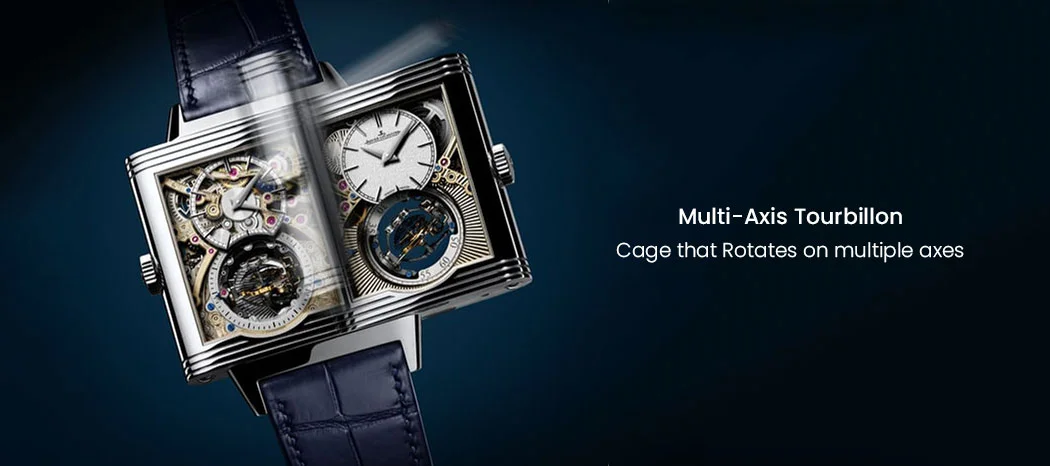
A multi-axis tourbillon is an advanced form of the traditional tourbillon complication, designed to counteract the effects of gravity on a watch’s movement from multiple angles. Unlike a standard tourbillon, which rotates on a single axis, multi-axis tourbillons feature additional rotational axes, allowing the escapement to move in multiple directions. This added complexity enhances timekeeping accuracy, making them a highly sought-after feature in haute horology.
What Makes Multi-Axis Tourbillons Special?
Multi-axis tourbillons stand out due to their intricate mechanical construction and mesmerizing movement. A standard tourbillon already requires extreme precision, but adding extra axes increases the complexity exponentially. These tourbillons provide a greater degree of compensation against gravitational effects, especially in wristwatches that frequently change orientation. Additionally, their constant motion creates a captivating visual spectacle, making them as much a piece of kinetic art as a timekeeping instrument.
Types of Multi-Axis Tourbillons
Double-Axis Tourbillon
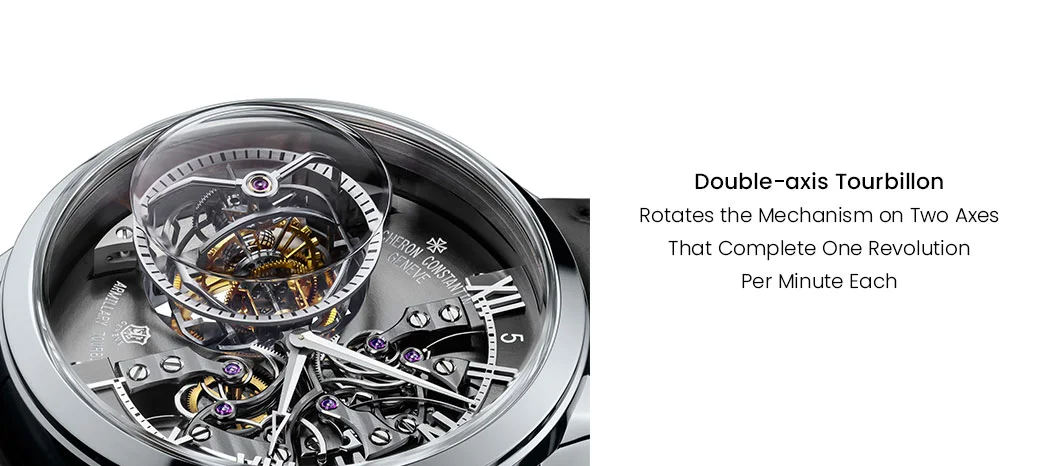
A double-axis tourbillon features two rotational axes, usually with the inner cage rotating in one direction and an outer cage rotating in another. This setup enhances chronometric stability as it counteracts positional errors more effectively than a single-axis tourbillon. One of the most famous double-axis tourbillons is Thomas Prescher’s invention, which paved the way for more complex multi-axis designs. Preacher is a celebrated clockmaker who has worked with brands like Audemars Piguet, Breguet, Gübelin etc and founded his company in 2002. He has invented sophisticated double and triple axis tourbillons.
Triple-Axis Tourbillon
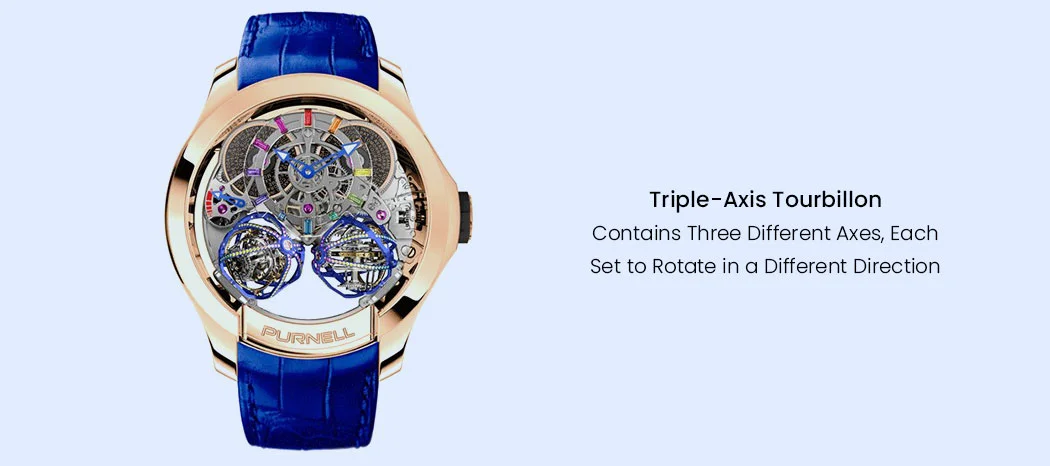
Taking complexity even further, a triple-axis tourbillon adds a third rotational plane, ensuring that the escapement is never in a fixed position relative to gravity. These tourbillons provide an even greater level of precision, but their construction requires an extraordinary level of craftsmanship. Thomas Prescher invented the first triple-axis tourbillon in 2004.
Double Tourbillon & Quadruple Tourbillon: Pushing the Boundaries of Horological Mechanics
Tourbillons were originally designed to counteract the effects of gravity on a watch’s movement, but modern advancements have led to even more sophisticated variations, including double tourbillons and quadruple tourbillons. These complex mechanisms go beyond the traditional single-axis tourbillon, enhancing accuracy and showcasing the pinnacle of haute horology by incorporating either two or four rotating cages within a single timepiece.
Double Tourbillon Or Twin Tourbillon
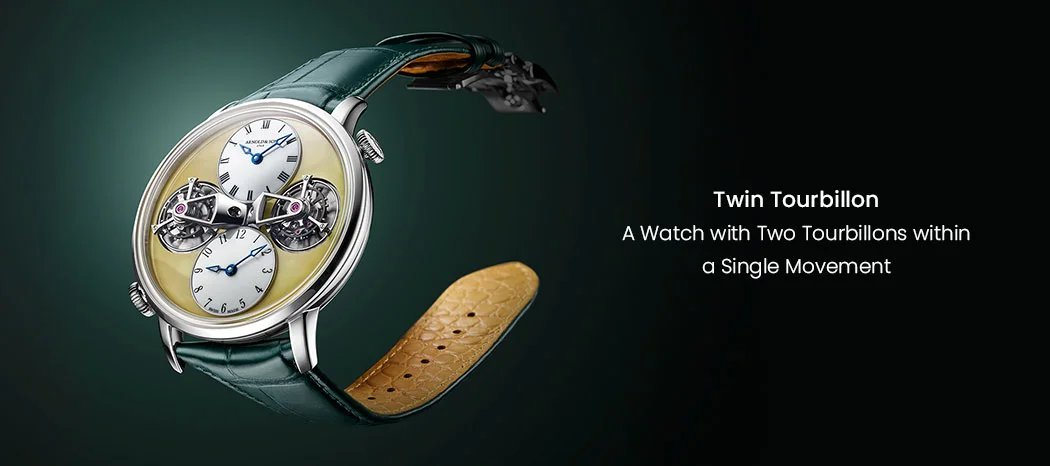
A double tourbillon watch consists of two tourbillons within a single movement, designed to enhance chronometric precision by counteracting gravitational effects in multiple orientations. There are two primary types of double tourbillons: the independent double tourbillon watch and the synchronized double tourbillon watch. In an independent double tourbillon, each tourbillon functions separately, regulating its gear train. This independent operation enhances stability and improves overall timekeeping accuracy. On the other hand, a synchronized double tourbillon features two tourbillons mechanically linked through a differential. This mechanism averages out rate variations between the two tourbillons, leading to greater precision. Both designs showcase the intricate craftsmanship and technical ingenuity required to refine mechanical timekeeping to its highest level.
Quadruple Tourbillon
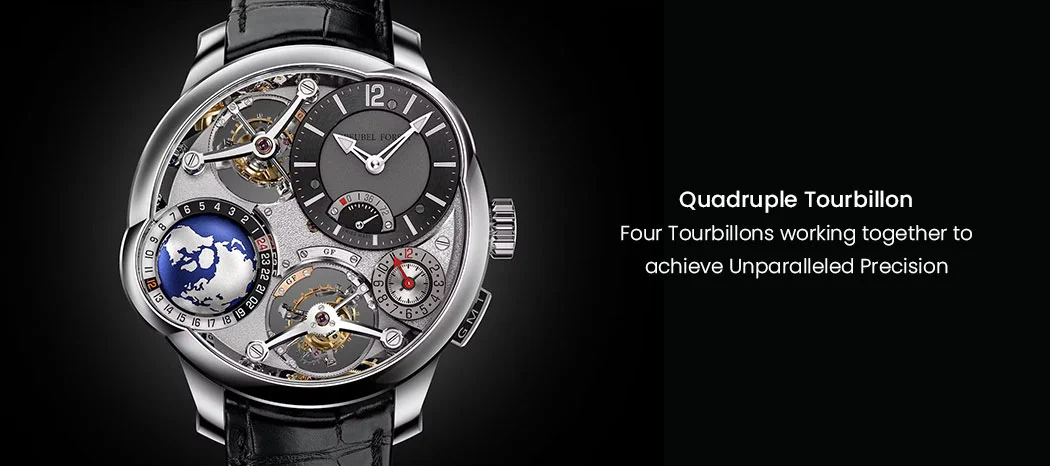
Taking innovation even further, a quadruple tourbillon features four independent tourbillons working together to achieve unparalleled precision. A quadruple tourbillon is a watch mechanism that incorporates four separate tourbillons within a single movement. This means the timepiece features four rotating cages, each designed to counteract the effects of gravity on the balance wheel, thereby enhancing the watch’s accuracy.
Defying Gravity: The Floating Elegance of the Flying Tourbillon
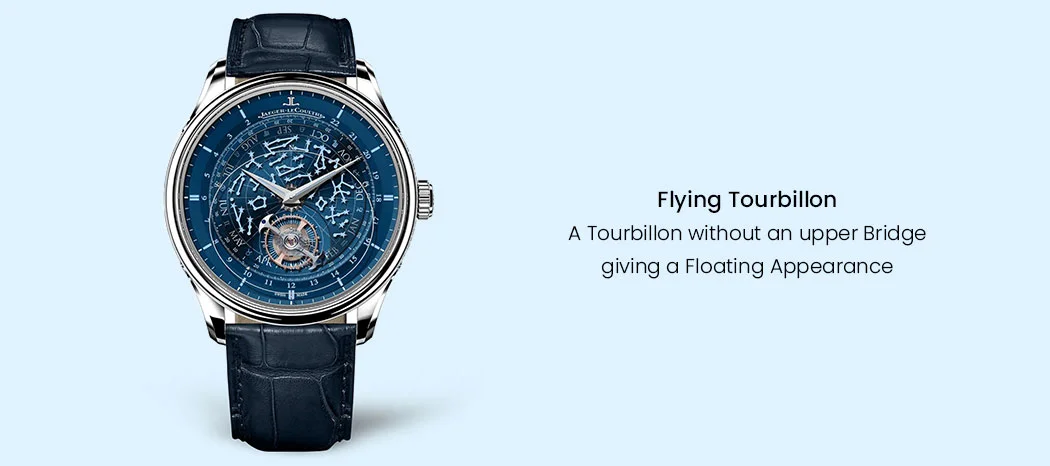
A flying tourbillon is a variation of the traditional tourbillon, distinguished by its unique design where the tourbillon cage is not supported by a bridge on one side, making it “fly” freely. A flying tourbillon watch offers a unique experience for the wearer. Unlike the traditional tourbillon, which is anchored at both the top and bottom, the flying tourbillon is only supported at a single attachment point, typically at the base, creating the illusion of floating in space. This mesmerizing visual display allows you to admire the elegant rotation of the mechanism through an open dial or sapphire bezel.
Seemingly defying gravity, the flying tourbillon serves as a true testament to the skill and craftsmanship of master watchmakers. This open construction creates a visually striking effect, allowing a clear view of the rotating mechanism. Despite the absence of a bridge on one side, the flying tourbillon is just as effective as its traditional counterpart in compensating for gravity-related inaccuracies in timekeeping. The floating design also reduces the overall height of the watch, contributing to a thinner profile and often a more refined aesthetic. This elegant complication has become a hallmark of high-end watchmaking, combining both mechanical sophistication and artistic beauty.
This masterpiece of a complication called the flying tourbillon was first developed by Alfred Helwig in 1920 at the Glashütte School Of Watchmaking.
Gyro Tourbillons: A Step Beyond Traditional Timekeeping
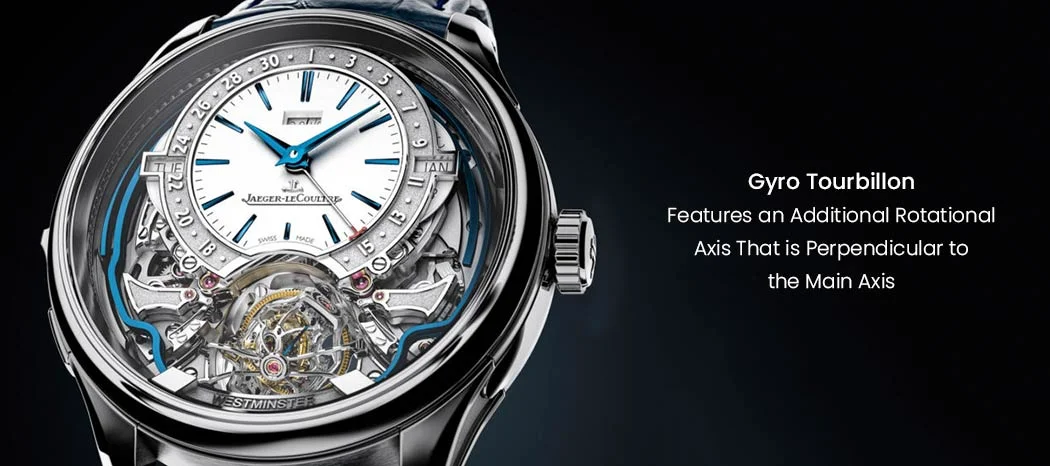
A gyro tourbillon is a sophisticated and highly complex variation of the traditional tourbillon. Unlike the conventional tourbillon, which rotates on a single axis, the gyro tourbillon rotates on multiple axes—typically two or even three—resulting in a unique, multi-dimensional movement. This additional complexity aims to further enhance the watch’s precision by compensating for gravitational effects from different orientations, which is especially useful for wristwatches, as they frequently change positions throughout the day.
Gyro tourbillons are extraordinary due to their mechanical complexity and the level of craftsmanship required to create them. The primary advantage of the gyro tourbillon is its ability to counteract the effects of gravity more effectively than a single-axis or even double-axis tourbillon. By rotating on multiple axes, the gyro tourbillon ensures that the escapement remains in constant motion, reducing the effects of gravity no matter how the watch is oriented.
The out of the world Gyrotourbillon was developed by Eric Coudray at Jaeger-LeCoultre in 2004.
OTHER VARIANTS:
The Slimmest Tourbillon
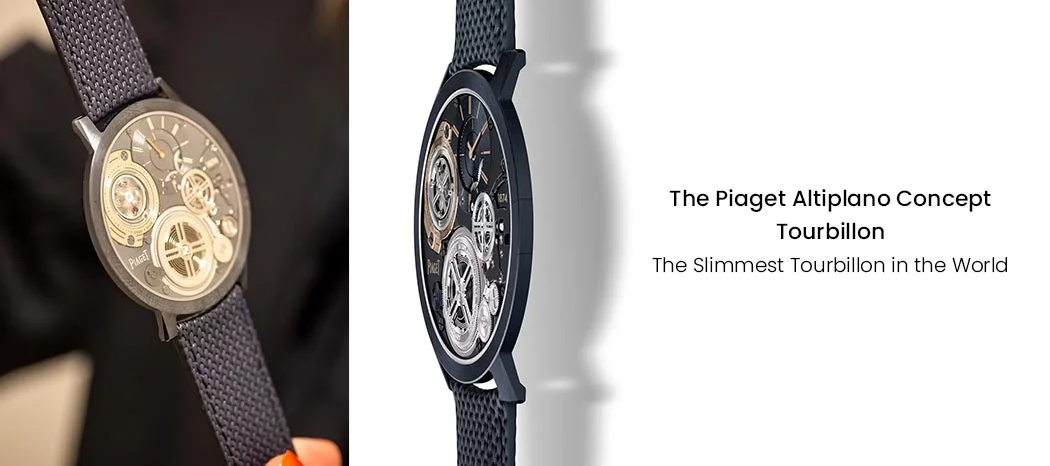
The Piaget Altiplano Ultimate Concept Tourbillon watch sets a new benchmark in ultra-thin watchmaking, measuring an astonishing 2 mm in thickness. Building on the groundbreaking 2018 Altiplano, Piaget has now integrated a tourbillon, making it the world’s slimmest of its kind. Housed in a striking cobalt blue PVD-treated case measuring 41.5mm, this marvel required a complete redesign of 90% of its movement to accommodate the tourbillon, which demands 25% more power from the mainspring. Positioned at 10 o’clock, the tourbillon operates on ball bearings rather than traditional pivots, enabling a sapphire caseback window for enhanced visibility, while the exposed mainspring barrel at 6 o’clock adds to its technical allure. The Piaget Altiplano tourbillon watch price is available on request,
The Tiniest Tourbillon

The Serpenti Seduttori Tourbillon watch by Bulgari is a true masterpiece of miniaturized haute horology, featuring the groundbreaking BVL150 movement—the smallest tourbillon currently in production. This hand-wound caliber, which took two years to develop, measures an astonishingly compact 22mm x 18mm with a thickness of just 3.65mm.
One of the most striking aspects of the BVL150 tourbillon watch is its tourbillon cage, which measures 10.88mm in diameter. While the overall movement is exceptionally small, Bulgari ensured that the tourbillon remains a visually captivating centerpiece. The brand achieved this delicate balance by leveraging modern precision fabrication techniques such as wire erosion, which allowed for the creation of an ultra-compact mechanism without sacrificing aesthetics or performance. Historically, tourbillon movements of this size have been produced in very limited numbers, making the BVL150 a rare and remarkable achievement in the world of watchmaking.
In addition to its intricate craftsmanship and visual appeal, the BVL150 Tourbillon watch is also highly functional. Despite its unconventional shape and small dimensions, Bulgari has managed to extract a respectable 40-hour power reserve from the movement, ensuring reliable performance. The BVL150 tourbillon watch price starts at INR 67,71,944 approximately.
The price of a tourbillon watch varies significantly based on its complexity, craftsmanship, and the type of tourbillon it features. Generally, the more intricate the design, the higher the price. Single-axis tourbillon watch price tend to be more affordable, while multi-axis tourbillons, such as double and triple tourbillons, are typically the most expensive due to their mechanical complexity and the precision required to create them. Among these, gyro tourbillons and quadruple tourbillons often command the highest prices, as they involve multiple rotating axes and are considered the pinnacle of horological innovation.
Kapoor Watch Company:
Kapoor Watch Company is a distinguished Indian retailer offering an expansive collection of luxury watch brands from around the world, including renowned names such as Bulgari, Cartier, Franck Muller and more. With a reputation for curating the finest in horology, we provide discerning customers with access to coveted timepieces, showcasing the artistry and precision of the world’s most prestigious watchmakers. In addition to our exceptional range of watches, we also boast an expansive catalog of fine jewelry and other luxury accessories, ensuring that every need for elegance and sophistication is met. With a commitment to quality, craftsmanship, and personalized service, Kapoor Watch Company stands as a symbol of luxury and refinement, bringing the best of international luxury to the Indian market. Visit Kapoor Watch Co. website OR Visit Kapoor Watch Co. Stores to check out our catalogue.





Recent Posts
Recent Comments
Archives